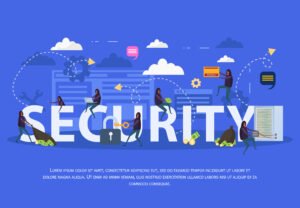Cybersecurity Awareness: Most Common Attacks and How to Stay Protected

Cybersecurity Awareness is important in today’s online world. Hackers use smart tricks daily to steal your personal or work information and data.
This blog shares common cyber attacks and safety tips. Whether you’re a student, worker, or business owner, knowing these threats can help you stay protected and secure online.
Disclaimer: - This post is for Cybersecurity Awareness Purpose only.
1. Phishing Attacks

Phishing is the most common cyber attack. Hackers send fake emails to steal sensitive information like passwords and credit card numbers. Phishing is important for Cybersecurity Awareness. Data shows that mostly hackers hack companies through phishing email.
How It Works:
Phishing emails look real. They may ask you to click on a link or download a file. These lead to fake websites or malware infections.
Precaution Tips:
-
Always check the sender’s email address.
-
Do not click unknown links or attachments.
-
Use email filters to detect spam.
-
Report suspicious emails to IT support.
2. Ransomware Attacks

Ransomware encrypts your files and demands payment for access. It causes huge data loss and financial damage.
How It Works:
You download a file or click a malicious link. Malware locks your files and shows a ransom message.
Precaution Tips:
-
Regularly back up your data.
-
Install antivirus and anti-ransomware tools.
-
Avoid downloading files from untrusted sources.
-
Keep software updated with security patches.
3. Social Engineering Attacks

Social engineering tricks people into giving sensitive information. It exploits human behavior rather than system flaws.
It often involves fake emails, calls, or messages that appear trustworthy. Hackers act like friends, coworkers, or companies to gain your trust.
Once trust is gained, they ask for sensitive data like passwords, account details, or financial information.
How It Works:
Hackers pose as trusted people like colleagues or IT staff. They may ask for passwords or access to systems.
Precaution Tips:
-
Never share passwords over email or phone.
-
Verify identity before sharing any sensitive data.
-
Train employees on social engineering awareness.
-
Use multi-factor authentication (MFA) to secure accounts.
4. Malware Attacks

Malware refers to viruses, worms, trojans, and spyware. It infects systems and steals or damages data.
How It Works:
Malware spreads through email, downloads, or infected USB drives. It operates silently and causes harm.
Precaution Tips:
-
Use reliable antivirus software.
-
Scan all external devices before use.
-
Do not download software from unknown websites.
-
Enable firewalls on all devices.
5. Man-in-the-Middle (MITM) Attacks

MITM attacks occur when hackers intercept communication between two parties. They can steal or modify data in real-time.
How It Works:
Hackers sit between you and a website. They capture login details, messages, or financial information.
Precaution Tips:
-
Avoid using public Wi-Fi for sensitive activities.
-
Use a VPN to encrypt your internet traffic.
-
Check for HTTPS in website URLs.
-
Log out of accounts after use.
6. USB Rubber Ducky

A USB Rubber Ducky is a malicious USB device that looks like a normal flash drive but acts like a keyboard. When plugged into a computer, it quickly types and executes pre-programmed commands to hack or control the system.
How It Works:
When inserted into a computer, the USB Rubber Ducky acts like a keyboard instead of a regular USB drive. It types pre-programmed commands automatically at a speed much faster than any human could, making it highly effective and difficult to detect in real time.
These commands can perform harmful actions such as opening command terminals, disabling antivirus programs, stealing sensitive data, downloading malicious files, or creating secret back doors. Since it functions as a keyboard, it bypasses USB storage restrictions, making it a stealthy and dangerous tool for attackers.
Precaution Tips:
-
Never plug in unknown or found USB devices.
-
Disable unused USB ports on sensitive systems.
-
Use endpoint protection software with USB control features.
-
Implement device whitelisting to allow only trusted hardware.
-
Educate employees about the risks of malicious USB devices.
7. Brute Force Attacks

Brute force attacks try all possible combinations to guess passwords. Weak or reused passwords are easy targets.
How It Works:
Automated tools try thousands of password combinations quickly. Once successful, they access your account.
Precaution Tips:
-
Use strong, unique passwords for each account.
-
Enable account lockout after failed attempts.
-
Use MFA to add another security layer.
-
Avoid using dictionary words as passwords.
8. Zero-Day Exploits

Zero-day exploits use unknown software bugs. Hackers attack systems before developers can fix the vulnerabilities.
How It Works:
Hackers find a flaw and attack before it’s publicly disclosed. These attacks are highly dangerous and hard to stop.
Precaution Tips:
-
Regularly update all software and systems.
-
Subscribe to vendor security alerts.
-
Use behavior-based antivirus tools.
-
Monitor system logs for suspicious activity.
9. DNS Spoofing (DNS Cache Poisoning)

DNS spoofing redirects you to fake websites. It tricks your system into visiting a malicious IP address.
How It Works:
Hackers change the DNS cache of a device or server. You think you’re on the right site but you’re not.
Precaution Tips:
-
Use DNSSEC (DNS Security Extensions).
-
Avoid clicking unknown links.
-
Clear DNS cache regularly.
-
Monitor network traffic for anomalies.
10. Insider Threats

Insider threats come from employees or partners with access to systems. They may act maliciously or make mistakes.
How It Works:
An insider misuses access to leak, delete, or steal data. It may be accidental or intentional.
Precaution Tips:
-
Limit access based on roles.
-
Monitor user activity logs.
-
Conduct regular security training.
-
Revoke access when employees leave.
11. Denial of Service (DoS/DDoS) Attacks

DoS or DDoS attacks flood servers with traffic. This causes system slowdowns or shutdowns, making services unavailable.
How It Works:
Attackers use botnets or scripts to send a flood of requests. It overloads your server and crashes it.
Precaution Tips:
-
Use DDoS protection services.
-
Set traffic limits with rate limiting.
-
Monitor traffic for abnormal patterns.
-
Maintain backup servers for emergencies.
12. Credential Stuffing Attacks

Credential stuffing uses leaked credentials from one breach to access accounts elsewhere. It exploits password reuse.
How It Works:
Hackers use automated tools to test stolen credentials. If reused, access is granted instantly.
Precaution Tips:
-
Do not reuse passwords across sites.
-
Use password managers to generate strong passwords.
-
Enable MFA on all accounts.
-
Monitor for unusual login locations.
13. Drive-By Downloads

Drive-by downloads occur when visiting infected websites. Malware installs without your knowledge or consent.
How It Works:
An outdated browser or plugin is exploited. Just visiting a page is enough to trigger infection.
Precaution Tips:
-
Keep your browser and plugins updated.
-
Avoid visiting unknown websites.
-
Block pop-ups and auto-downloads.
-
Use web protection features in antivirus tools.
Conclusion: Stay Cyber Safe

Cybersecurity Awareness is everyone’s responsibility. Hackers target the weakest link — usually human error. Stay informed, alert, and cautious.
Train your team, update software, and follow security best practices. Awareness is the first step to protection.
Secure your digital life with strong passwords, regular backups, and multi-layered security measures.
Be proactive. Stay informed. Defend your data.